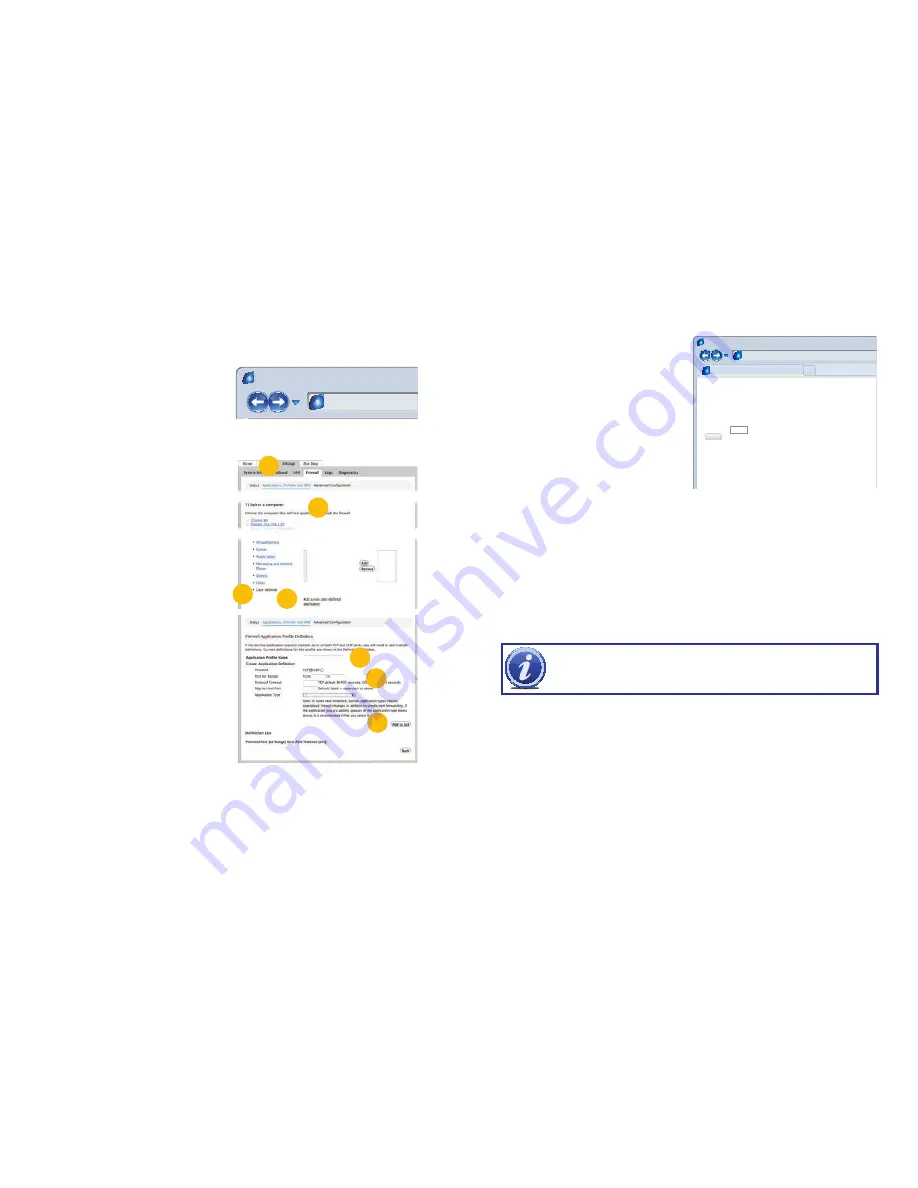
10
11
PICTURE 1-10
OPTION 3: OPENING PORTS USING DMZ ON 2WIRE ROUTERS
Accessing your router’s DMZ controls:
2Wire brand routers are currently the exclusive router used for AT&T’s Uverse and other
Internet servers. Their configuration protocols are different enough that you should follow
these instructions rather than the generic router instructions in Option 2 if you are an AT&T
customer.
PICTURE 1-9
Browser - Windows Internet Explorer
Fine
100%
Web Client
Page Safety Tools
http://
10.6.196.6
Protected Mode: On
LIVE
SEARCH
BACKUP
TOOLS
INFO
CONFIG
2011-10-06 18:16:49
Status
P.T.Z
Color
Master Stream
Sub-Stream
Local Recording Status
1
2 3 4 5 6 7 8
9 10 11 12 13 14 15 16
1 2 3 4 5 6 7 8
9 10 11 12 13 14 15 16
2
4
3
5
6
10
7-8
STEP 1
. On a computer connected to
the same router as the NVR, open a
web browser and enter the Gateway
(Router’s IP address) into the browser
window’s address bar to access your
router.
STEP 2
. Click on the
Settings
tab and
then
Firewall
. Once in
Firewall
,
click on
Applications, Pinholes and
DMZ
.
STEP 3
. In the Select Your Computer
area, locate your NVR’s IP address
and click on it.
STEP 4
. Scroll down to select
User
Defined
.
STEP 5
. Click on A
dd a new user-
defined application
.
STEP 6
. In the box labeled
Application
Profile Name
, enter “NVR”.
STEP 7
. Ensure that TCP is selected.
STEP 8
. Enter 85 in the
From
and
To
boxes for
Port (or Range)
.
STEP 9
. Leave the next two boxes blank
to use the default settings.
STEP 10
. Click on
Add to List
. Your
router will require you to log in to
accept the settings. If you have not
created your own password for your
router, it is the 10-digit System Key
printed on the label on your router
between the square brackets “[ ]”.
STEP 11
. Once your settings have been confirmed, repeat
Steps 8-10
, this time
entering 37777 for the
From
and
To
ports.
STEP 12
. Click on
Back
and then select NVR from the list of Applications. Clicking on
Add
and then
Save
.
Leave your router control panel open as you will need to obtain DNS information from your
router in
Section 1.5 Domain Name System (DNS)
.
CONFIRMING THAT PORTS ARE OPENED
To confirm that your ports have been forwarded successfully, go to
www.canyouseeme.org
using a computer connected to the same router as the NVR.
STEP 1
. Enter “85” into the box labeled
“What Port?”
STEP 2
. Click on the
Check
button.
STEP 3
. You should see a green
“Success” message. If not, return to
the NVR’s Network window and, in
the Network tab, change port 85 to
81 or 83 and click Apply to save your
changes before checking using that
new number on CanYouSeeMe.
STEP 4
. Repeat for port 37777. If there
is a problem with port 37777, then try
37000 in the same manner as above.
This website will also display your Public IP address near the top of the page above the box
where you entered your port number. This is the number which you will use to access the NVR
using a web browser or your mobile device from outside of your local network (away from the
building in which your NVR is located).
PICTURE 1-11
NOTE!
If you are successful after changing from port 85, then you will need
to add that to the IP address when accessing the NVR via the Internet. If, for
example, you changed to port 81, the address would now read 64.245.112.90
:81
Browser - Windows Internet Explorer
Fine
100%
Open Port Check Tool
Page Safety Tools
http://canyouseeme.org/
Protected Mode: On
Your IP:
81.919.622.24
What Port?
CanYouSeeMe.org - Open Port Check Tool
Check
This page will serve as a free utility for remotely verifying a port is open or closed. It will
be useful for users who wish to check to see if a server or ISP is blocking certain ports.
Success:
I can see your service on
81.919.622.24
on port
(85)
Your ISP is not blocking port 85





















